Financial Management, Budgeting and Costing in Hospitality Report
VerifiedAdded on 2019/12/28
|14
|4158
|159
Report
AI Summary
This report provides a comprehensive analysis of financial management within the hospitality industry. It begins with an introduction to financial management and accounting, explaining the purposes of business accounting and the users of accounting reports. The report defines budgeting and its purpose, categorizes different types of costs, and explains the trial balance. It evaluates various sources of finance and delves into calculations, including room occupancy rates, depreciation, revenue percentages, break-even points, and profit analysis. The report then moves on to costing, with a detailed costing sheet for a recipe, and discusses the best ways for a restaurant to control its stock. Furthermore, it includes calculations for package deals, selling prices, and profit variance, concluding with recommendations and references. The report utilizes tables to present data such as depreciation calculations, revenue percentages, and break-even points to support the analysis. The report is a valuable resource for students studying finance and hospitality management.
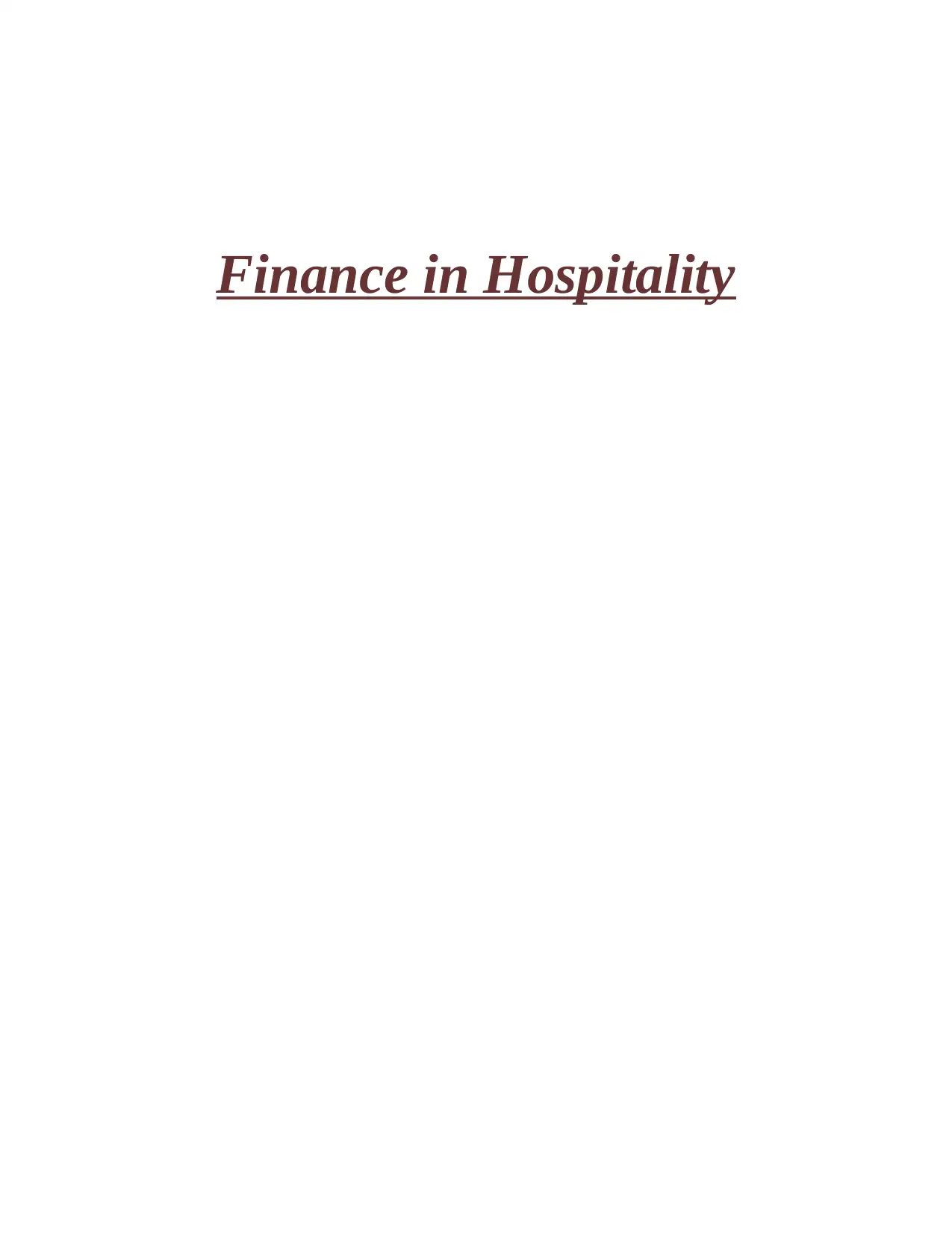
Finance in Hospitality
Paraphrase This Document
Need a fresh take? Get an instant paraphrase of this document with our AI Paraphraser
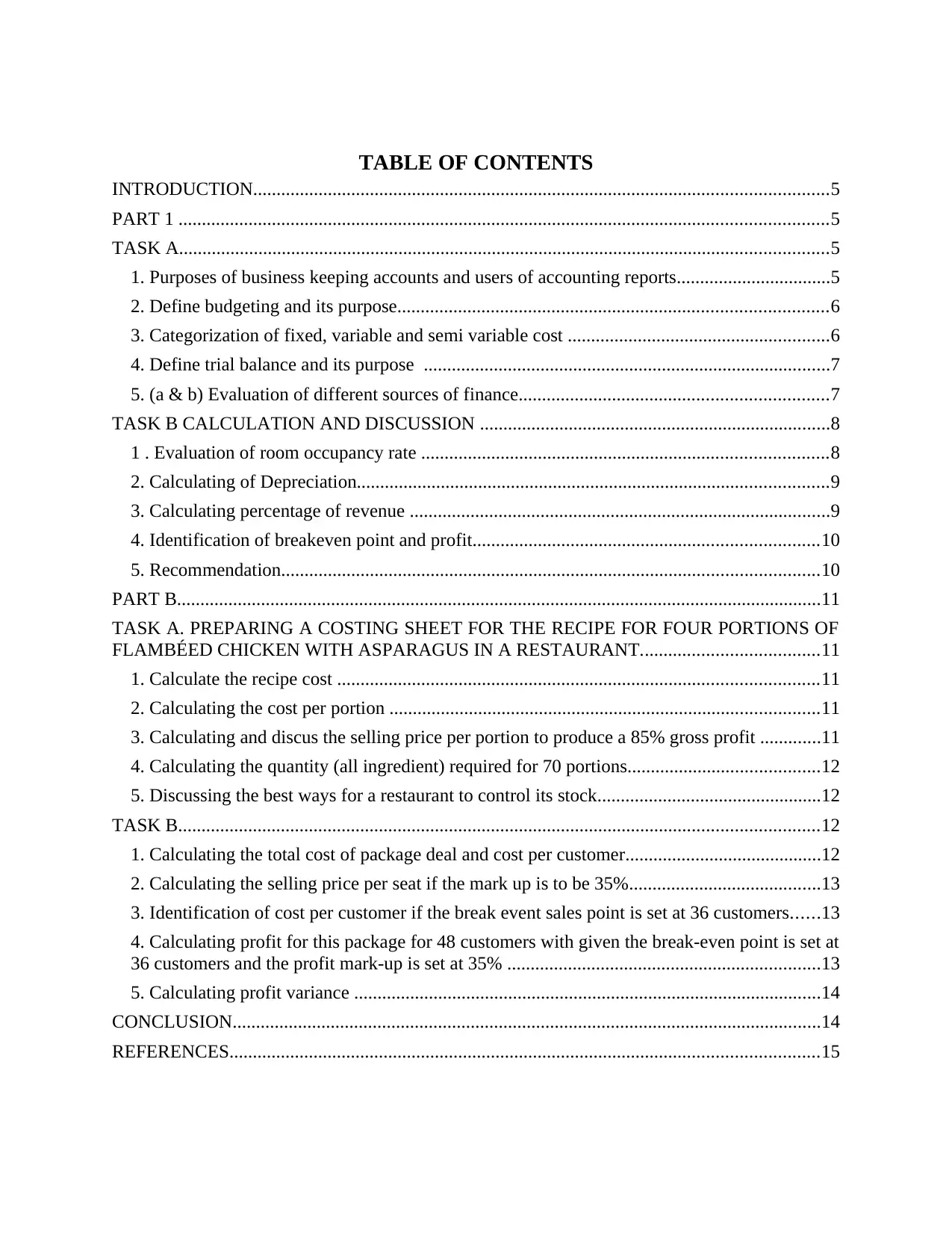
TABLE OF CONTENTS
INTRODUCTION...........................................................................................................................5
PART 1 ...........................................................................................................................................5
TASK A...........................................................................................................................................5
1. Purposes of business keeping accounts and users of accounting reports.................................5
2. Define budgeting and its purpose............................................................................................6
3. Categorization of fixed, variable and semi variable cost ........................................................6
4. Define trial balance and its purpose .......................................................................................7
5. (a & b) Evaluation of different sources of finance..................................................................7
TASK B CALCULATION AND DISCUSSION ...........................................................................8
1 . Evaluation of room occupancy rate .......................................................................................8
2. Calculating of Depreciation.....................................................................................................9
3. Calculating percentage of revenue ..........................................................................................9
4. Identification of breakeven point and profit..........................................................................10
5. Recommendation...................................................................................................................10
PART B..........................................................................................................................................11
TASK A. PREPARING A COSTING SHEET FOR THE RECIPE FOR FOUR PORTIONS OF
FLAMBÉED CHICKEN WITH ASPARAGUS IN A RESTAURANT......................................11
1. Calculate the recipe cost .......................................................................................................11
2. Calculating the cost per portion ............................................................................................11
3. Calculating and discus the selling price per portion to produce a 85% gross profit .............11
4. Calculating the quantity (all ingredient) required for 70 portions.........................................12
5. Discussing the best ways for a restaurant to control its stock................................................12
TASK B.........................................................................................................................................12
1. Calculating the total cost of package deal and cost per customer..........................................12
2. Calculating the selling price per seat if the mark up is to be 35%.........................................13
3. Identification of cost per customer if the break event sales point is set at 36 customers......13
4. Calculating profit for this package for 48 customers with given the break-even point is set at
36 customers and the profit mark-up is set at 35% ...................................................................13
5. Calculating profit variance ....................................................................................................14
CONCLUSION..............................................................................................................................14
REFERENCES..............................................................................................................................15
INTRODUCTION...........................................................................................................................5
PART 1 ...........................................................................................................................................5
TASK A...........................................................................................................................................5
1. Purposes of business keeping accounts and users of accounting reports.................................5
2. Define budgeting and its purpose............................................................................................6
3. Categorization of fixed, variable and semi variable cost ........................................................6
4. Define trial balance and its purpose .......................................................................................7
5. (a & b) Evaluation of different sources of finance..................................................................7
TASK B CALCULATION AND DISCUSSION ...........................................................................8
1 . Evaluation of room occupancy rate .......................................................................................8
2. Calculating of Depreciation.....................................................................................................9
3. Calculating percentage of revenue ..........................................................................................9
4. Identification of breakeven point and profit..........................................................................10
5. Recommendation...................................................................................................................10
PART B..........................................................................................................................................11
TASK A. PREPARING A COSTING SHEET FOR THE RECIPE FOR FOUR PORTIONS OF
FLAMBÉED CHICKEN WITH ASPARAGUS IN A RESTAURANT......................................11
1. Calculate the recipe cost .......................................................................................................11
2. Calculating the cost per portion ............................................................................................11
3. Calculating and discus the selling price per portion to produce a 85% gross profit .............11
4. Calculating the quantity (all ingredient) required for 70 portions.........................................12
5. Discussing the best ways for a restaurant to control its stock................................................12
TASK B.........................................................................................................................................12
1. Calculating the total cost of package deal and cost per customer..........................................12
2. Calculating the selling price per seat if the mark up is to be 35%.........................................13
3. Identification of cost per customer if the break event sales point is set at 36 customers......13
4. Calculating profit for this package for 48 customers with given the break-even point is set at
36 customers and the profit mark-up is set at 35% ...................................................................13
5. Calculating profit variance ....................................................................................................14
CONCLUSION..............................................................................................................................14
REFERENCES..............................................................................................................................15
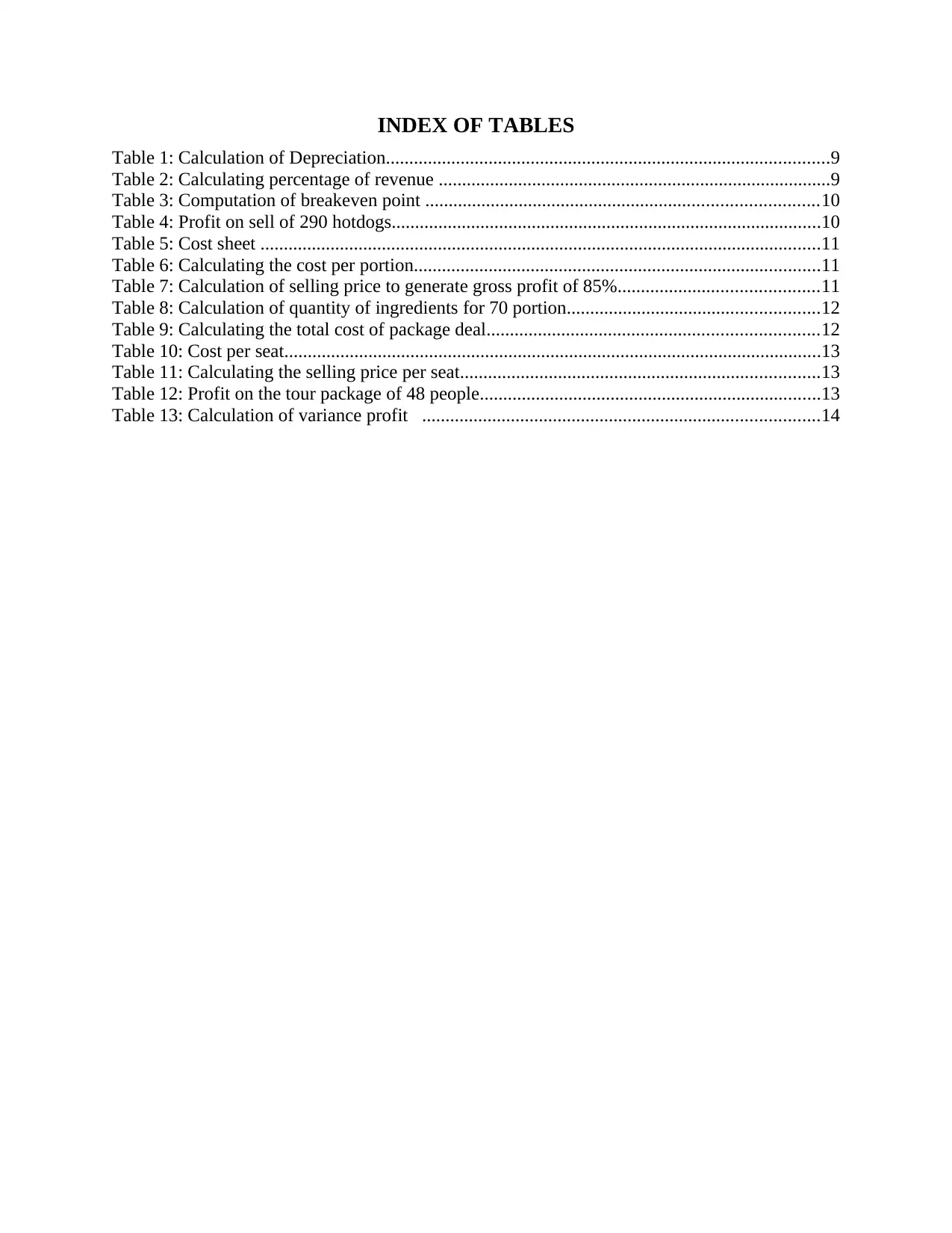
INDEX OF TABLES
Table 1: Calculation of Depreciation...............................................................................................9
Table 2: Calculating percentage of revenue ....................................................................................9
Table 3: Computation of breakeven point ....................................................................................10
Table 4: Profit on sell of 290 hotdogs............................................................................................10
Table 5: Cost sheet ........................................................................................................................11
Table 6: Calculating the cost per portion.......................................................................................11
Table 7: Calculation of selling price to generate gross profit of 85%...........................................11
Table 8: Calculation of quantity of ingredients for 70 portion......................................................12
Table 9: Calculating the total cost of package deal.......................................................................12
Table 10: Cost per seat...................................................................................................................13
Table 11: Calculating the selling price per seat.............................................................................13
Table 12: Profit on the tour package of 48 people.........................................................................13
Table 13: Calculation of variance profit .....................................................................................14
Table 1: Calculation of Depreciation...............................................................................................9
Table 2: Calculating percentage of revenue ....................................................................................9
Table 3: Computation of breakeven point ....................................................................................10
Table 4: Profit on sell of 290 hotdogs............................................................................................10
Table 5: Cost sheet ........................................................................................................................11
Table 6: Calculating the cost per portion.......................................................................................11
Table 7: Calculation of selling price to generate gross profit of 85%...........................................11
Table 8: Calculation of quantity of ingredients for 70 portion......................................................12
Table 9: Calculating the total cost of package deal.......................................................................12
Table 10: Cost per seat...................................................................................................................13
Table 11: Calculating the selling price per seat.............................................................................13
Table 12: Profit on the tour package of 48 people.........................................................................13
Table 13: Calculation of variance profit .....................................................................................14
⊘ This is a preview!⊘
Do you want full access?
Subscribe today to unlock all pages.

Trusted by 1+ million students worldwide
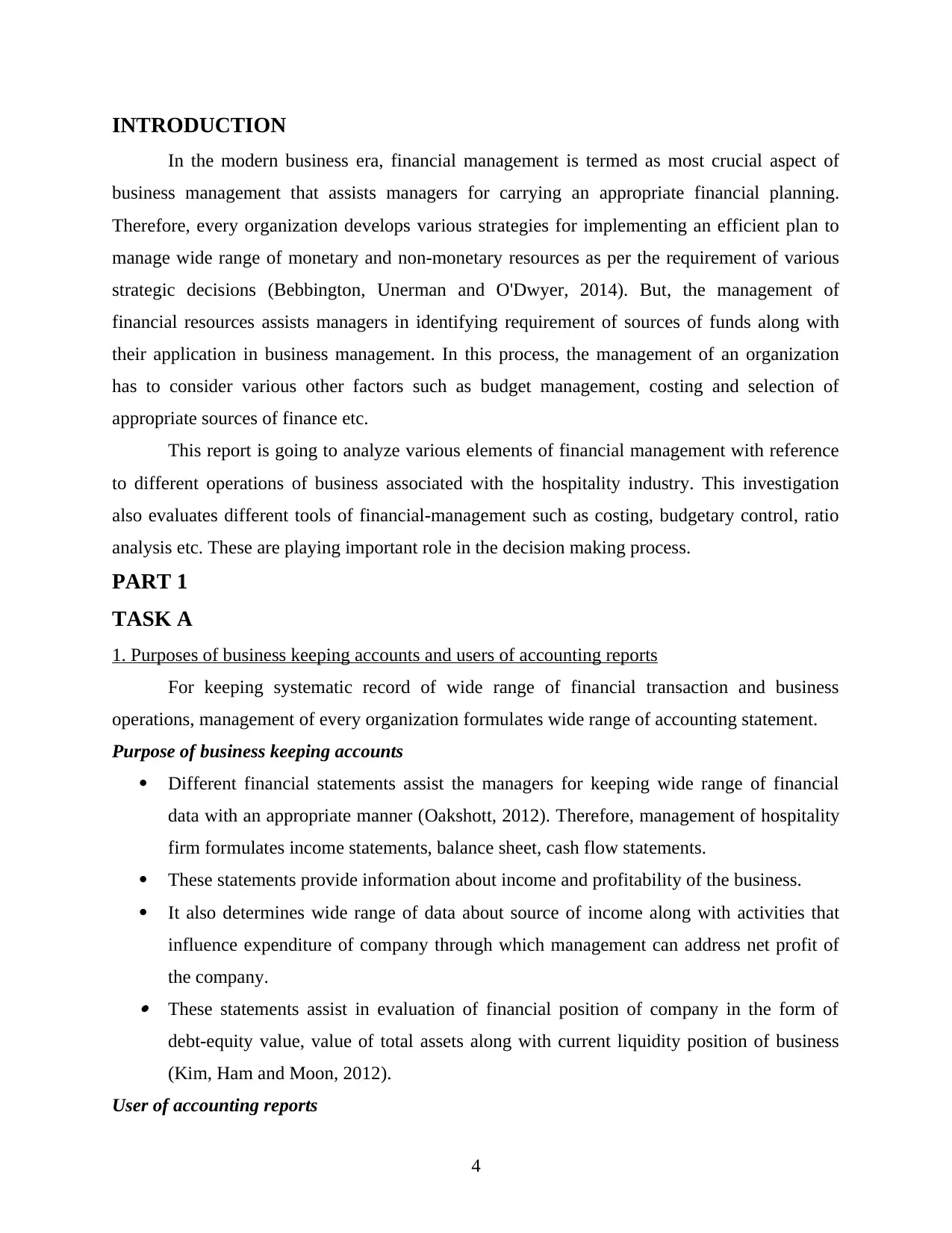
INTRODUCTION
In the modern business era, financial management is termed as most crucial aspect of
business management that assists managers for carrying an appropriate financial planning.
Therefore, every organization develops various strategies for implementing an efficient plan to
manage wide range of monetary and non-monetary resources as per the requirement of various
strategic decisions (Bebbington, Unerman and O'Dwyer, 2014). But, the management of
financial resources assists managers in identifying requirement of sources of funds along with
their application in business management. In this process, the management of an organization
has to consider various other factors such as budget management, costing and selection of
appropriate sources of finance etc.
This report is going to analyze various elements of financial management with reference
to different operations of business associated with the hospitality industry. This investigation
also evaluates different tools of financial-management such as costing, budgetary control, ratio
analysis etc. These are playing important role in the decision making process.
PART 1
TASK A
1. Purposes of business keeping accounts and users of accounting reports
For keeping systematic record of wide range of financial transaction and business
operations, management of every organization formulates wide range of accounting statement.
Purpose of business keeping accounts
Different financial statements assist the managers for keeping wide range of financial
data with an appropriate manner (Oakshott, 2012). Therefore, management of hospitality
firm formulates income statements, balance sheet, cash flow statements.
These statements provide information about income and profitability of the business.
It also determines wide range of data about source of income along with activities that
influence expenditure of company through which management can address net profit of
the company. These statements assist in evaluation of financial position of company in the form of
debt-equity value, value of total assets along with current liquidity position of business
(Kim, Ham and Moon, 2012).
User of accounting reports
4
In the modern business era, financial management is termed as most crucial aspect of
business management that assists managers for carrying an appropriate financial planning.
Therefore, every organization develops various strategies for implementing an efficient plan to
manage wide range of monetary and non-monetary resources as per the requirement of various
strategic decisions (Bebbington, Unerman and O'Dwyer, 2014). But, the management of
financial resources assists managers in identifying requirement of sources of funds along with
their application in business management. In this process, the management of an organization
has to consider various other factors such as budget management, costing and selection of
appropriate sources of finance etc.
This report is going to analyze various elements of financial management with reference
to different operations of business associated with the hospitality industry. This investigation
also evaluates different tools of financial-management such as costing, budgetary control, ratio
analysis etc. These are playing important role in the decision making process.
PART 1
TASK A
1. Purposes of business keeping accounts and users of accounting reports
For keeping systematic record of wide range of financial transaction and business
operations, management of every organization formulates wide range of accounting statement.
Purpose of business keeping accounts
Different financial statements assist the managers for keeping wide range of financial
data with an appropriate manner (Oakshott, 2012). Therefore, management of hospitality
firm formulates income statements, balance sheet, cash flow statements.
These statements provide information about income and profitability of the business.
It also determines wide range of data about source of income along with activities that
influence expenditure of company through which management can address net profit of
the company. These statements assist in evaluation of financial position of company in the form of
debt-equity value, value of total assets along with current liquidity position of business
(Kim, Ham and Moon, 2012).
User of accounting reports
4
Paraphrase This Document
Need a fresh take? Get an instant paraphrase of this document with our AI Paraphraser
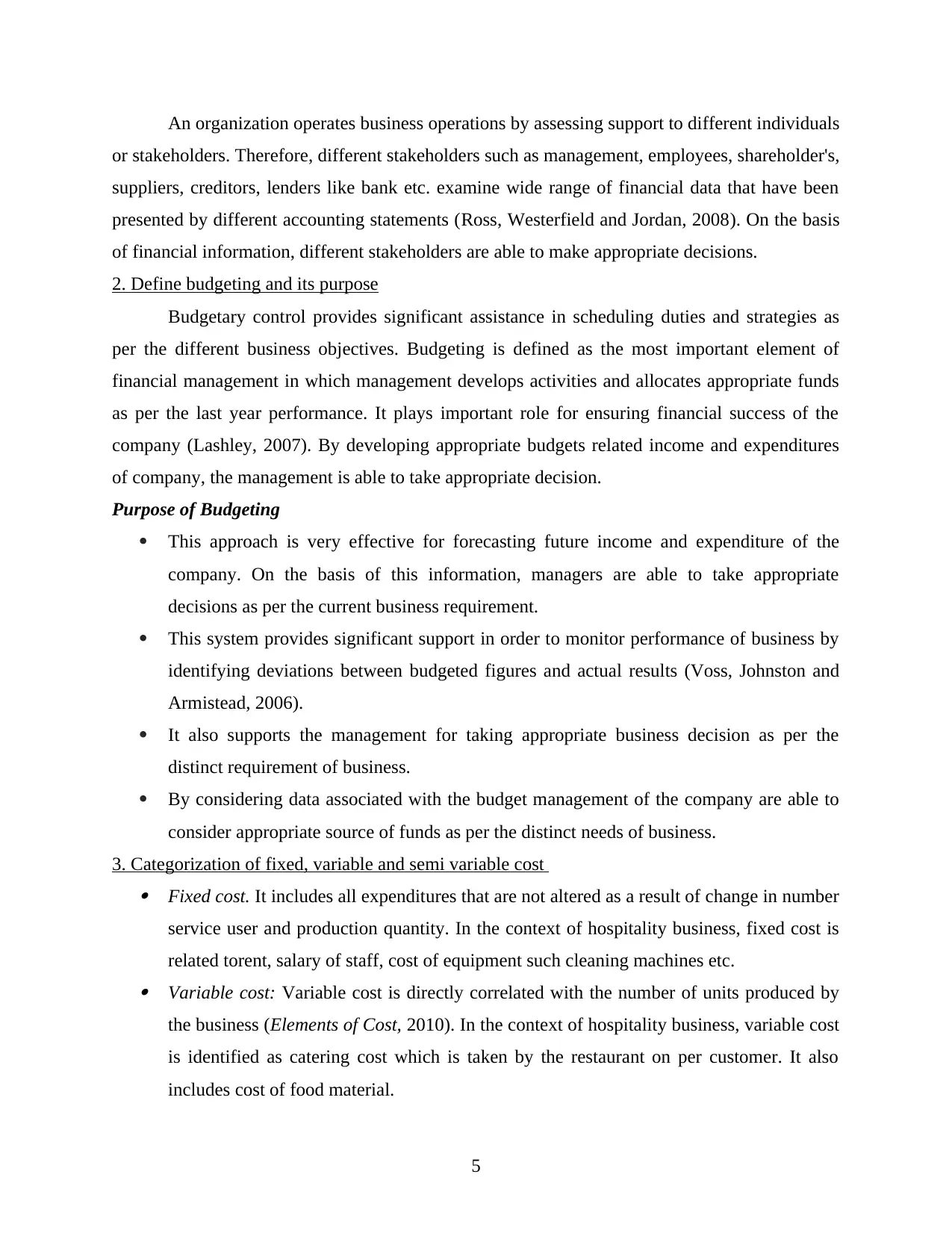
An organization operates business operations by assessing support to different individuals
or stakeholders. Therefore, different stakeholders such as management, employees, shareholder's,
suppliers, creditors, lenders like bank etc. examine wide range of financial data that have been
presented by different accounting statements (Ross, Westerfield and Jordan, 2008). On the basis
of financial information, different stakeholders are able to make appropriate decisions.
2. Define budgeting and its purpose
Budgetary control provides significant assistance in scheduling duties and strategies as
per the different business objectives. Budgeting is defined as the most important element of
financial management in which management develops activities and allocates appropriate funds
as per the last year performance. It plays important role for ensuring financial success of the
company (Lashley, 2007). By developing appropriate budgets related income and expenditures
of company, the management is able to take appropriate decision.
Purpose of Budgeting
This approach is very effective for forecasting future income and expenditure of the
company. On the basis of this information, managers are able to take appropriate
decisions as per the current business requirement.
This system provides significant support in order to monitor performance of business by
identifying deviations between budgeted figures and actual results (Voss, Johnston and
Armistead, 2006).
It also supports the management for taking appropriate business decision as per the
distinct requirement of business.
By considering data associated with the budget management of the company are able to
consider appropriate source of funds as per the distinct needs of business.
3. Categorization of fixed, variable and semi variable cost Fixed cost. It includes all expenditures that are not altered as a result of change in number
service user and production quantity. In the context of hospitality business, fixed cost is
related torent, salary of staff, cost of equipment such cleaning machines etc. Variable cost: Variable cost is directly correlated with the number of units produced by
the business (Elements of Cost, 2010). In the context of hospitality business, variable cost
is identified as catering cost which is taken by the restaurant on per customer. It also
includes cost of food material.
5
or stakeholders. Therefore, different stakeholders such as management, employees, shareholder's,
suppliers, creditors, lenders like bank etc. examine wide range of financial data that have been
presented by different accounting statements (Ross, Westerfield and Jordan, 2008). On the basis
of financial information, different stakeholders are able to make appropriate decisions.
2. Define budgeting and its purpose
Budgetary control provides significant assistance in scheduling duties and strategies as
per the different business objectives. Budgeting is defined as the most important element of
financial management in which management develops activities and allocates appropriate funds
as per the last year performance. It plays important role for ensuring financial success of the
company (Lashley, 2007). By developing appropriate budgets related income and expenditures
of company, the management is able to take appropriate decision.
Purpose of Budgeting
This approach is very effective for forecasting future income and expenditure of the
company. On the basis of this information, managers are able to take appropriate
decisions as per the current business requirement.
This system provides significant support in order to monitor performance of business by
identifying deviations between budgeted figures and actual results (Voss, Johnston and
Armistead, 2006).
It also supports the management for taking appropriate business decision as per the
distinct requirement of business.
By considering data associated with the budget management of the company are able to
consider appropriate source of funds as per the distinct needs of business.
3. Categorization of fixed, variable and semi variable cost Fixed cost. It includes all expenditures that are not altered as a result of change in number
service user and production quantity. In the context of hospitality business, fixed cost is
related torent, salary of staff, cost of equipment such cleaning machines etc. Variable cost: Variable cost is directly correlated with the number of units produced by
the business (Elements of Cost, 2010). In the context of hospitality business, variable cost
is identified as catering cost which is taken by the restaurant on per customer. It also
includes cost of food material.
5
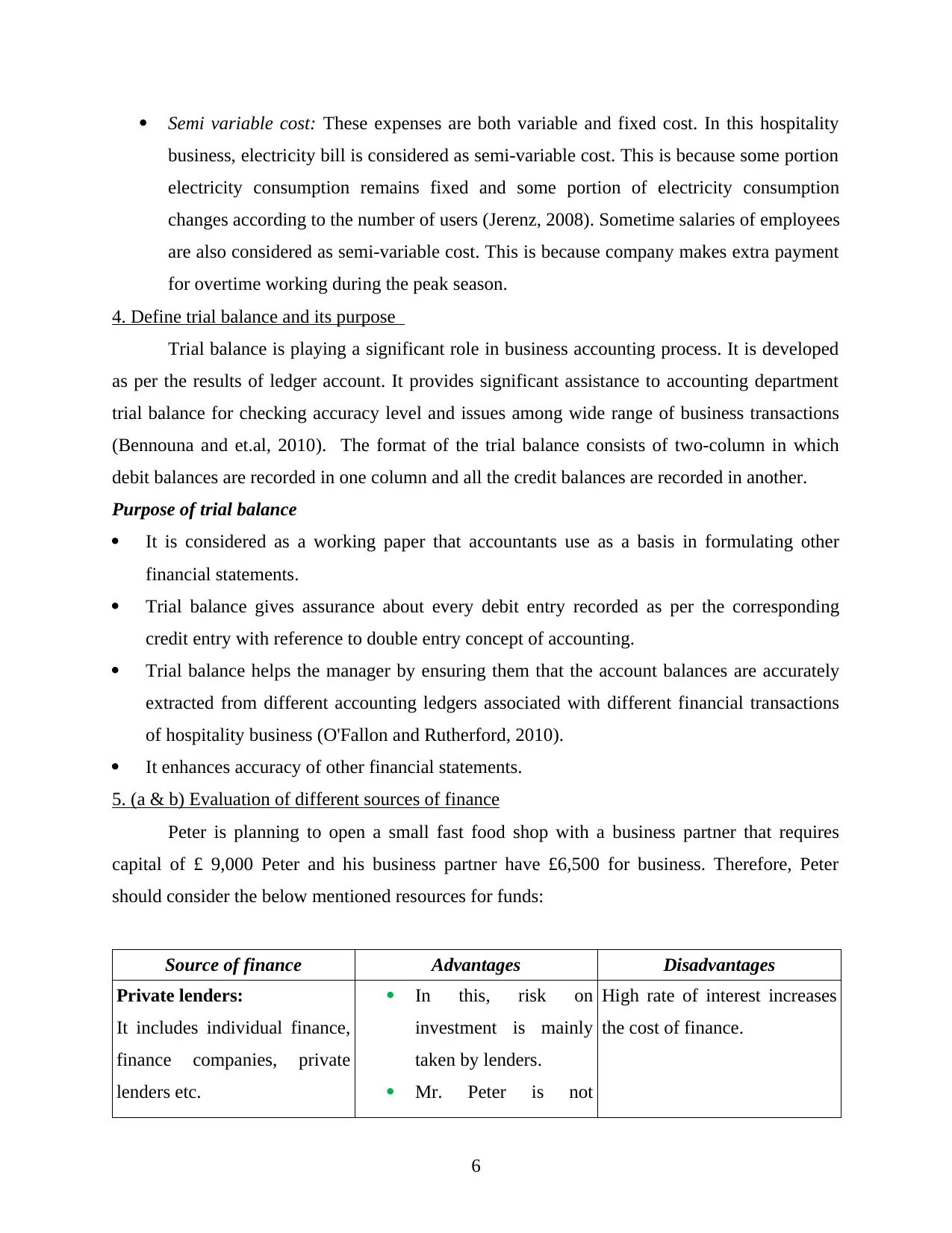
Semi variable cost: These expenses are both variable and fixed cost. In this hospitality
business, electricity bill is considered as semi-variable cost. This is because some portion
electricity consumption remains fixed and some portion of electricity consumption
changes according to the number of users (Jerenz, 2008). Sometime salaries of employees
are also considered as semi-variable cost. This is because company makes extra payment
for overtime working during the peak season.
4. Define trial balance and its purpose
Trial balance is playing a significant role in business accounting process. It is developed
as per the results of ledger account. It provides significant assistance to accounting department
trial balance for checking accuracy level and issues among wide range of business transactions
(Bennouna and et.al, 2010). The format of the trial balance consists of two-column in which
debit balances are recorded in one column and all the credit balances are recorded in another.
Purpose of trial balance
It is considered as a working paper that accountants use as a basis in formulating other
financial statements.
Trial balance gives assurance about every debit entry recorded as per the corresponding
credit entry with reference to double entry concept of accounting.
Trial balance helps the manager by ensuring them that the account balances are accurately
extracted from different accounting ledgers associated with different financial transactions
of hospitality business (O'Fallon and Rutherford, 2010).
It enhances accuracy of other financial statements.
5. (a & b) Evaluation of different sources of finance
Peter is planning to open a small fast food shop with a business partner that requires
capital of £ 9,000 Peter and his business partner have £6,500 for business. Therefore, Peter
should consider the below mentioned resources for funds:
Source of finance Advantages Disadvantages
Private lenders:
It includes individual finance,
finance companies, private
lenders etc.
In this, risk on
investment is mainly
taken by lenders.
Mr. Peter is not
High rate of interest increases
the cost of finance.
6
business, electricity bill is considered as semi-variable cost. This is because some portion
electricity consumption remains fixed and some portion of electricity consumption
changes according to the number of users (Jerenz, 2008). Sometime salaries of employees
are also considered as semi-variable cost. This is because company makes extra payment
for overtime working during the peak season.
4. Define trial balance and its purpose
Trial balance is playing a significant role in business accounting process. It is developed
as per the results of ledger account. It provides significant assistance to accounting department
trial balance for checking accuracy level and issues among wide range of business transactions
(Bennouna and et.al, 2010). The format of the trial balance consists of two-column in which
debit balances are recorded in one column and all the credit balances are recorded in another.
Purpose of trial balance
It is considered as a working paper that accountants use as a basis in formulating other
financial statements.
Trial balance gives assurance about every debit entry recorded as per the corresponding
credit entry with reference to double entry concept of accounting.
Trial balance helps the manager by ensuring them that the account balances are accurately
extracted from different accounting ledgers associated with different financial transactions
of hospitality business (O'Fallon and Rutherford, 2010).
It enhances accuracy of other financial statements.
5. (a & b) Evaluation of different sources of finance
Peter is planning to open a small fast food shop with a business partner that requires
capital of £ 9,000 Peter and his business partner have £6,500 for business. Therefore, Peter
should consider the below mentioned resources for funds:
Source of finance Advantages Disadvantages
Private lenders:
It includes individual finance,
finance companies, private
lenders etc.
In this, risk on
investment is mainly
taken by lenders.
Mr. Peter is not
High rate of interest increases
the cost of finance.
6
⊘ This is a preview!⊘
Do you want full access?
Subscribe today to unlock all pages.

Trusted by 1+ million students worldwide
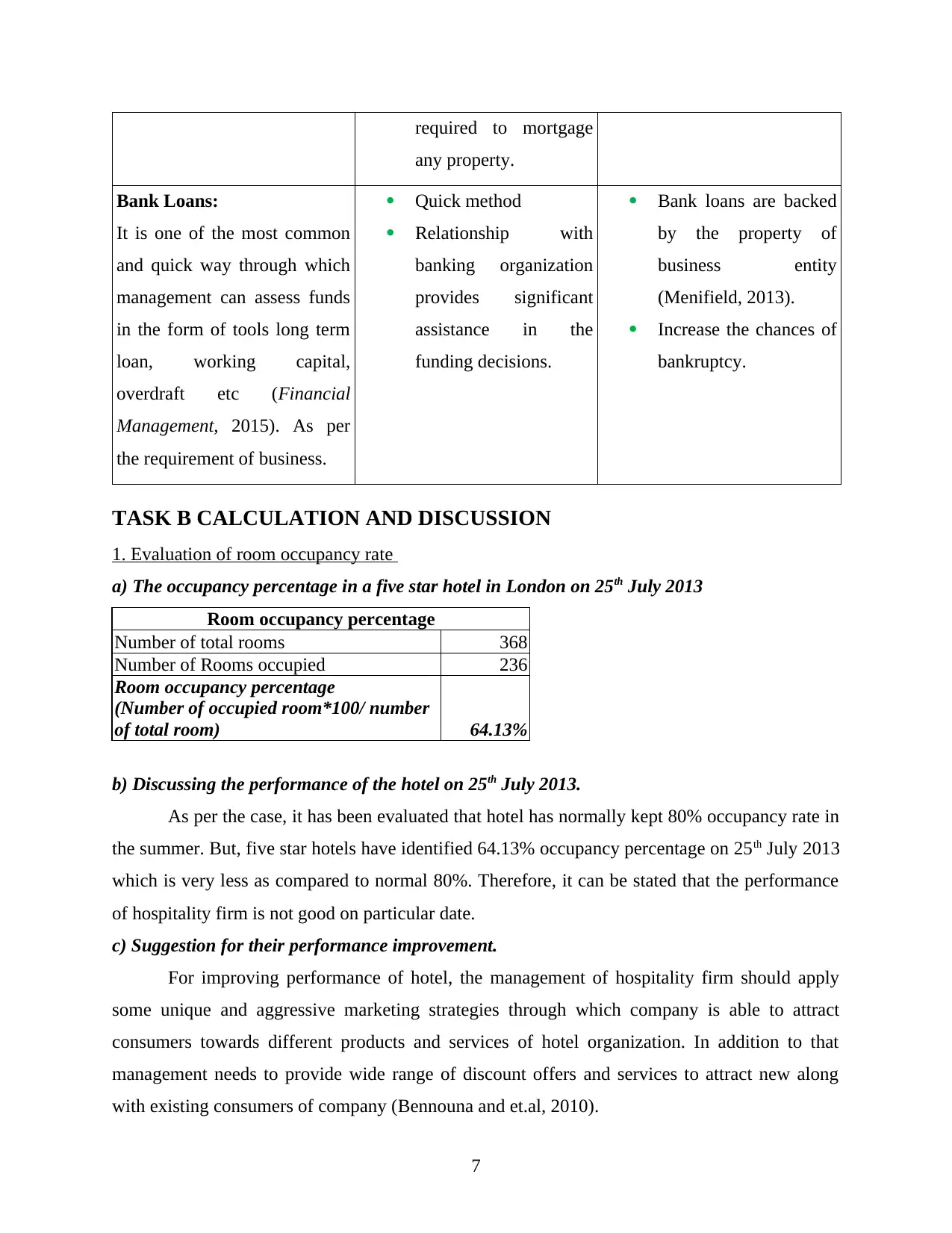
required to mortgage
any property.
Bank Loans:
It is one of the most common
and quick way through which
management can assess funds
in the form of tools long term
loan, working capital,
overdraft etc (Financial
Management, 2015). As per
the requirement of business.
Quick method
Relationship with
banking organization
provides significant
assistance in the
funding decisions.
Bank loans are backed
by the property of
business entity
(Menifield, 2013).
Increase the chances of
bankruptcy.
TASK B CALCULATION AND DISCUSSION
1. Evaluation of room occupancy rate
a) The occupancy percentage in a five star hotel in London on 25th July 2013
Room occupancy percentage
Number of total rooms 368
Number of Rooms occupied 236
Room occupancy percentage
(Number of occupied room*100/ number
of total room) 64.13%
b) Discussing the performance of the hotel on 25th July 2013.
As per the case, it has been evaluated that hotel has normally kept 80% occupancy rate in
the summer. But, five star hotels have identified 64.13% occupancy percentage on 25th July 2013
which is very less as compared to normal 80%. Therefore, it can be stated that the performance
of hospitality firm is not good on particular date.
c) Suggestion for their performance improvement.
For improving performance of hotel, the management of hospitality firm should apply
some unique and aggressive marketing strategies through which company is able to attract
consumers towards different products and services of hotel organization. In addition to that
management needs to provide wide range of discount offers and services to attract new along
with existing consumers of company (Bennouna and et.al, 2010).
7
any property.
Bank Loans:
It is one of the most common
and quick way through which
management can assess funds
in the form of tools long term
loan, working capital,
overdraft etc (Financial
Management, 2015). As per
the requirement of business.
Quick method
Relationship with
banking organization
provides significant
assistance in the
funding decisions.
Bank loans are backed
by the property of
business entity
(Menifield, 2013).
Increase the chances of
bankruptcy.
TASK B CALCULATION AND DISCUSSION
1. Evaluation of room occupancy rate
a) The occupancy percentage in a five star hotel in London on 25th July 2013
Room occupancy percentage
Number of total rooms 368
Number of Rooms occupied 236
Room occupancy percentage
(Number of occupied room*100/ number
of total room) 64.13%
b) Discussing the performance of the hotel on 25th July 2013.
As per the case, it has been evaluated that hotel has normally kept 80% occupancy rate in
the summer. But, five star hotels have identified 64.13% occupancy percentage on 25th July 2013
which is very less as compared to normal 80%. Therefore, it can be stated that the performance
of hospitality firm is not good on particular date.
c) Suggestion for their performance improvement.
For improving performance of hotel, the management of hospitality firm should apply
some unique and aggressive marketing strategies through which company is able to attract
consumers towards different products and services of hotel organization. In addition to that
management needs to provide wide range of discount offers and services to attract new along
with existing consumers of company (Bennouna and et.al, 2010).
7
Paraphrase This Document
Need a fresh take? Get an instant paraphrase of this document with our AI Paraphraser
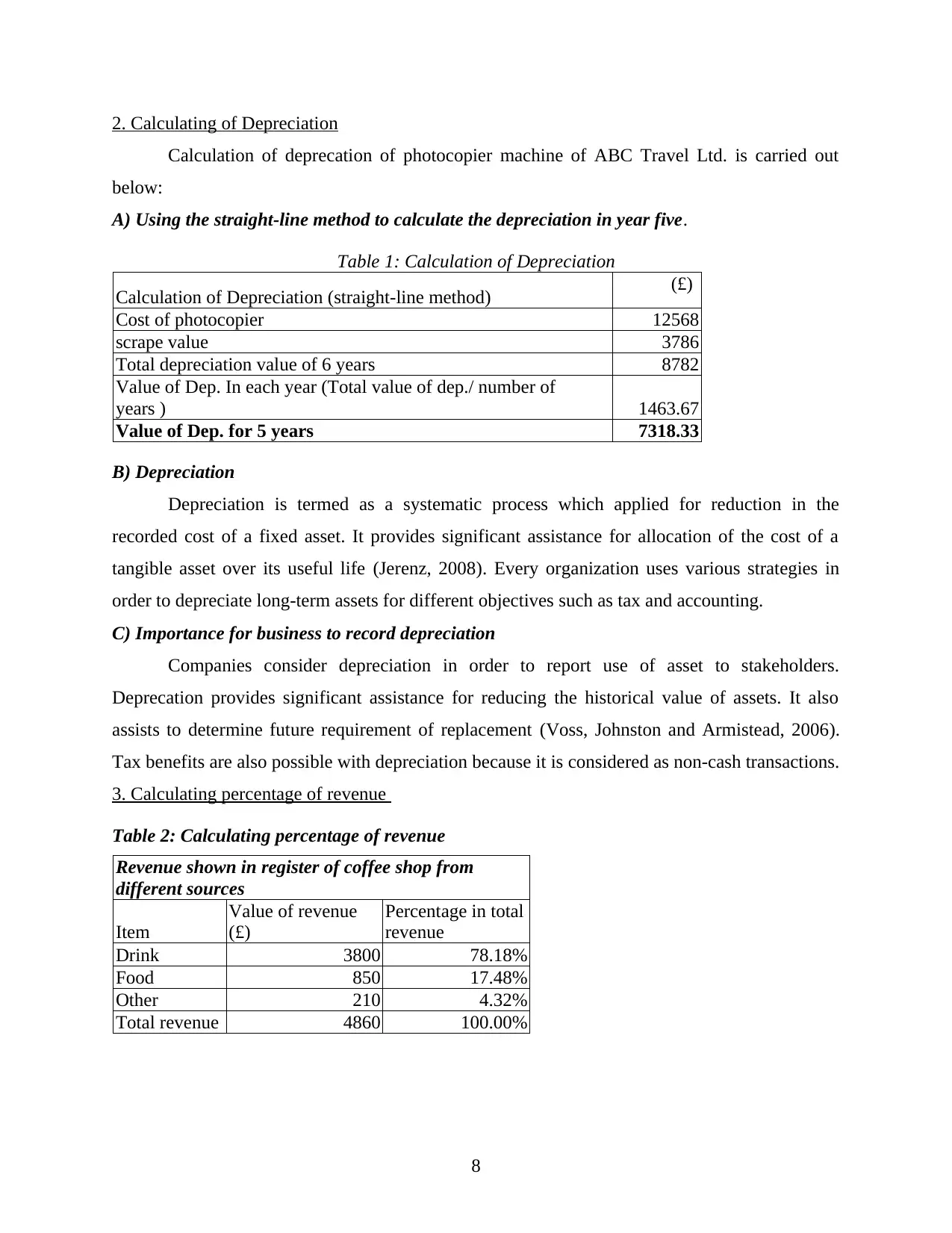
2. Calculating of Depreciation
Calculation of deprecation of photocopier machine of ABC Travel Ltd. is carried out
below:
A) Using the straight-line method to calculate the depreciation in year five.
Table 1: Calculation of Depreciation
Calculation of Depreciation (straight-line method) (£)
Cost of photocopier 12568
scrape value 3786
Total depreciation value of 6 years 8782
Value of Dep. In each year (Total value of dep./ number of
years ) 1463.67
Value of Dep. for 5 years 7318.33
B) Depreciation
Depreciation is termed as a systematic process which applied for reduction in the
recorded cost of a fixed asset. It provides significant assistance for allocation of the cost of a
tangible asset over its useful life (Jerenz, 2008). Every organization uses various strategies in
order to depreciate long-term assets for different objectives such as tax and accounting.
C) Importance for business to record depreciation
Companies consider depreciation in order to report use of asset to stakeholders.
Deprecation provides significant assistance for reducing the historical value of assets. It also
assists to determine future requirement of replacement (Voss, Johnston and Armistead, 2006).
Tax benefits are also possible with depreciation because it is considered as non-cash transactions.
3. Calculating percentage of revenue
Table 2: Calculating percentage of revenue
Revenue shown in register of coffee shop from
different sources
Item
Value of revenue
(£)
Percentage in total
revenue
Drink 3800 78.18%
Food 850 17.48%
Other 210 4.32%
Total revenue 4860 100.00%
8
Calculation of deprecation of photocopier machine of ABC Travel Ltd. is carried out
below:
A) Using the straight-line method to calculate the depreciation in year five.
Table 1: Calculation of Depreciation
Calculation of Depreciation (straight-line method) (£)
Cost of photocopier 12568
scrape value 3786
Total depreciation value of 6 years 8782
Value of Dep. In each year (Total value of dep./ number of
years ) 1463.67
Value of Dep. for 5 years 7318.33
B) Depreciation
Depreciation is termed as a systematic process which applied for reduction in the
recorded cost of a fixed asset. It provides significant assistance for allocation of the cost of a
tangible asset over its useful life (Jerenz, 2008). Every organization uses various strategies in
order to depreciate long-term assets for different objectives such as tax and accounting.
C) Importance for business to record depreciation
Companies consider depreciation in order to report use of asset to stakeholders.
Deprecation provides significant assistance for reducing the historical value of assets. It also
assists to determine future requirement of replacement (Voss, Johnston and Armistead, 2006).
Tax benefits are also possible with depreciation because it is considered as non-cash transactions.
3. Calculating percentage of revenue
Table 2: Calculating percentage of revenue
Revenue shown in register of coffee shop from
different sources
Item
Value of revenue
(£)
Percentage in total
revenue
Drink 3800 78.18%
Food 850 17.48%
Other 210 4.32%
Total revenue 4860 100.00%
8
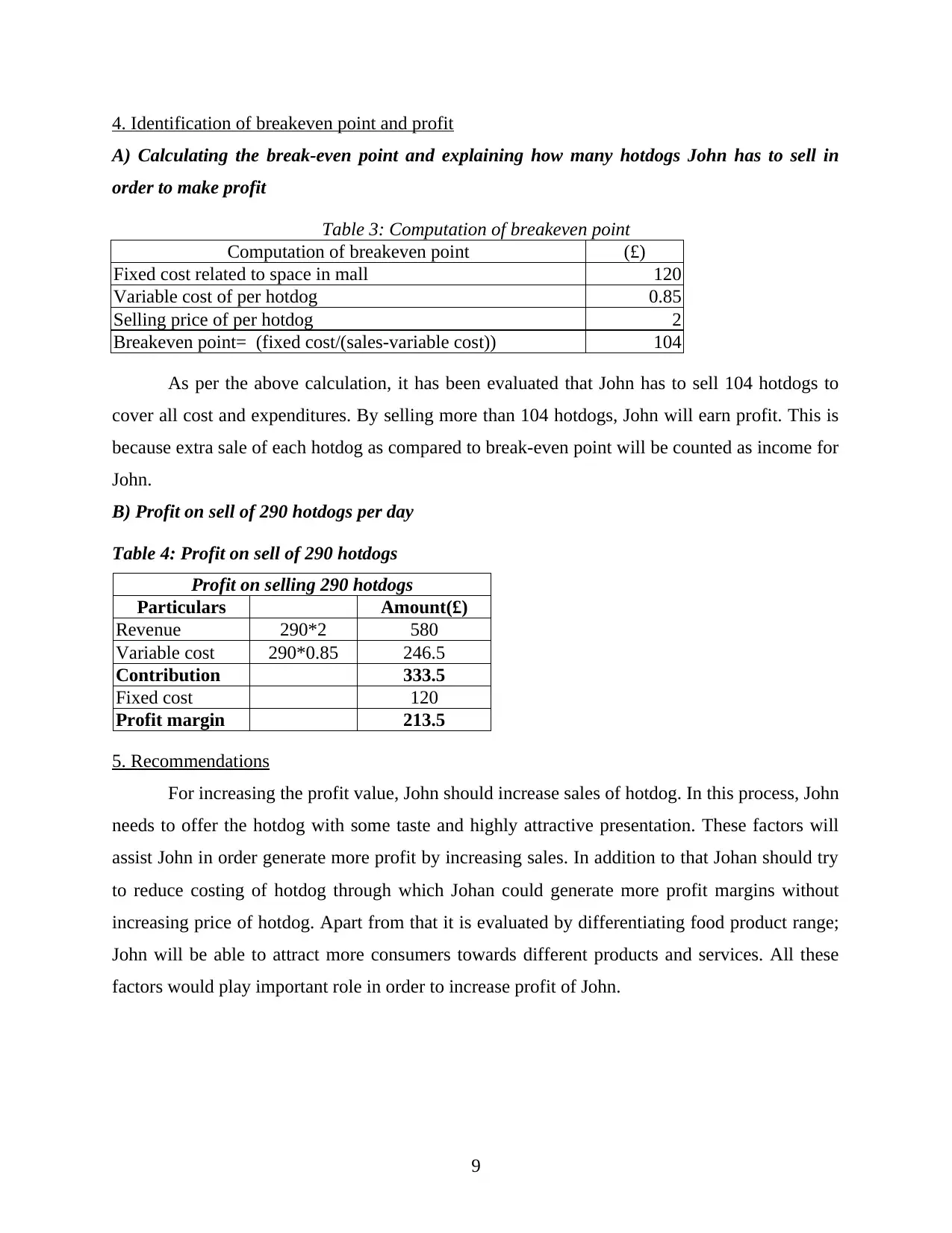
4. Identification of breakeven point and profit
A) Calculating the break-even point and explaining how many hotdogs John has to sell in
order to make profit
Table 3: Computation of breakeven point
Computation of breakeven point (£)
Fixed cost related to space in mall 120
Variable cost of per hotdog 0.85
Selling price of per hotdog 2
Breakeven point= (fixed cost/(sales-variable cost)) 104
As per the above calculation, it has been evaluated that John has to sell 104 hotdogs to
cover all cost and expenditures. By selling more than 104 hotdogs, John will earn profit. This is
because extra sale of each hotdog as compared to break-even point will be counted as income for
John.
B) Profit on sell of 290 hotdogs per day
Table 4: Profit on sell of 290 hotdogs
Profit on selling 290 hotdogs
Particulars Amount(£)
Revenue 290*2 580
Variable cost 290*0.85 246.5
Contribution 333.5
Fixed cost 120
Profit margin 213.5
5. Recommendations
For increasing the profit value, John should increase sales of hotdog. In this process, John
needs to offer the hotdog with some taste and highly attractive presentation. These factors will
assist John in order generate more profit by increasing sales. In addition to that Johan should try
to reduce costing of hotdog through which Johan could generate more profit margins without
increasing price of hotdog. Apart from that it is evaluated by differentiating food product range;
John will be able to attract more consumers towards different products and services. All these
factors would play important role in order to increase profit of John.
9
A) Calculating the break-even point and explaining how many hotdogs John has to sell in
order to make profit
Table 3: Computation of breakeven point
Computation of breakeven point (£)
Fixed cost related to space in mall 120
Variable cost of per hotdog 0.85
Selling price of per hotdog 2
Breakeven point= (fixed cost/(sales-variable cost)) 104
As per the above calculation, it has been evaluated that John has to sell 104 hotdogs to
cover all cost and expenditures. By selling more than 104 hotdogs, John will earn profit. This is
because extra sale of each hotdog as compared to break-even point will be counted as income for
John.
B) Profit on sell of 290 hotdogs per day
Table 4: Profit on sell of 290 hotdogs
Profit on selling 290 hotdogs
Particulars Amount(£)
Revenue 290*2 580
Variable cost 290*0.85 246.5
Contribution 333.5
Fixed cost 120
Profit margin 213.5
5. Recommendations
For increasing the profit value, John should increase sales of hotdog. In this process, John
needs to offer the hotdog with some taste and highly attractive presentation. These factors will
assist John in order generate more profit by increasing sales. In addition to that Johan should try
to reduce costing of hotdog through which Johan could generate more profit margins without
increasing price of hotdog. Apart from that it is evaluated by differentiating food product range;
John will be able to attract more consumers towards different products and services. All these
factors would play important role in order to increase profit of John.
9
⊘ This is a preview!⊘
Do you want full access?
Subscribe today to unlock all pages.

Trusted by 1+ million students worldwide
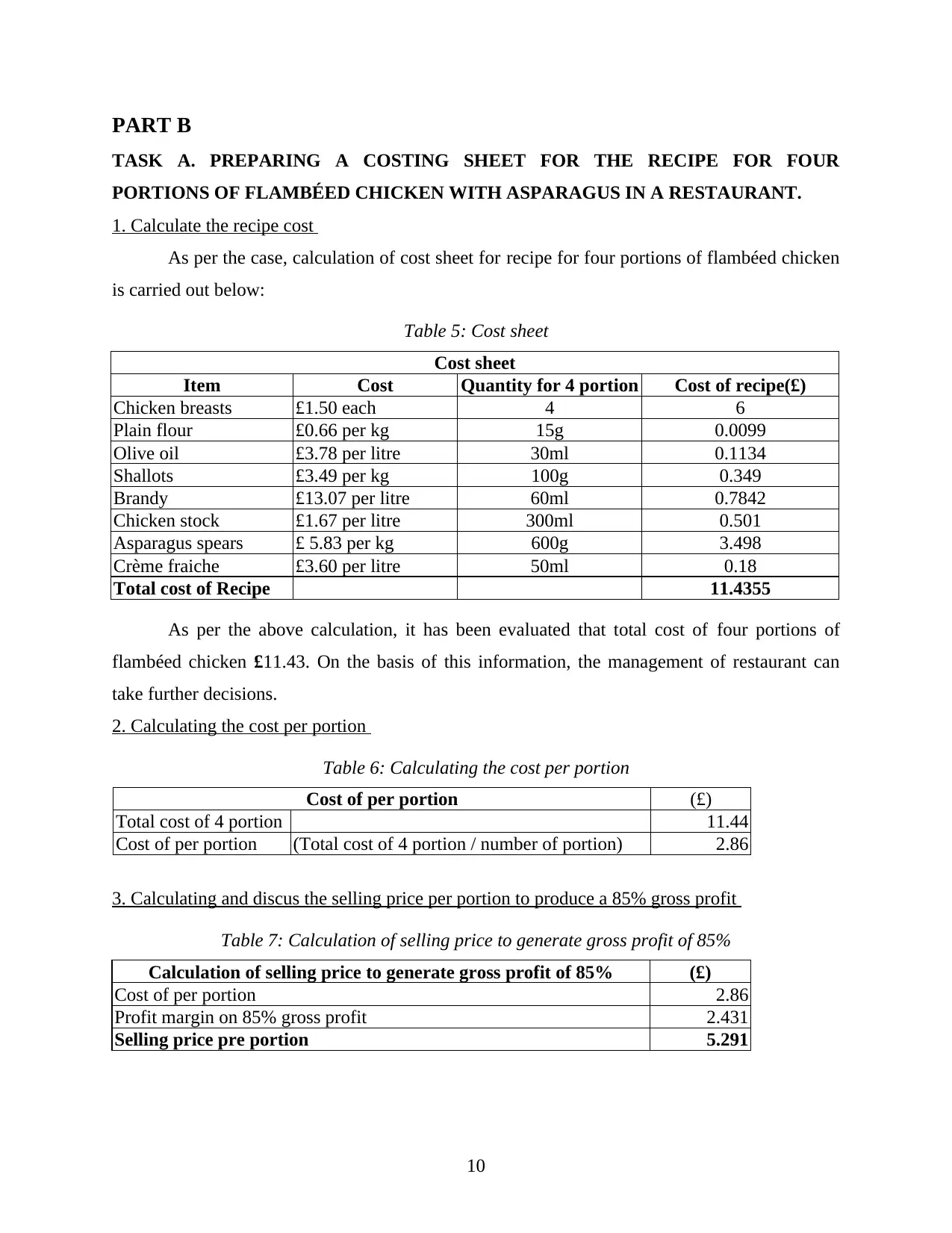
PART B
TASK A. PREPARING A COSTING SHEET FOR THE RECIPE FOR FOUR
PORTIONS OF FLAMBÉED CHICKEN WITH ASPARAGUS IN A RESTAURANT.
1. Calculate the recipe cost
As per the case, calculation of cost sheet for recipe for four portions of flambéed chicken
is carried out below:
Table 5: Cost sheet
Cost sheet
Item Cost Quantity for 4 portion Cost of recipe(£)
Chicken breasts £1.50 each 4 6
Plain flour £0.66 per kg 15g 0.0099
Olive oil £3.78 per litre 30ml 0.1134
Shallots £3.49 per kg 100g 0.349
Brandy £13.07 per litre 60ml 0.7842
Chicken stock £1.67 per litre 300ml 0.501
Asparagus spears £ 5.83 per kg 600g 3.498
Crème fraiche £3.60 per litre 50ml 0.18
Total cost of Recipe 11.4355
As per the above calculation, it has been evaluated that total cost of four portions of
flambéed chicken £11.43. On the basis of this information, the management of restaurant can
take further decisions.
2. Calculating the cost per portion
Table 6: Calculating the cost per portion
Cost of per portion (£)
Total cost of 4 portion 11.44
Cost of per portion (Total cost of 4 portion / number of portion) 2.86
3. Calculating and discus the selling price per portion to produce a 85% gross profit
Table 7: Calculation of selling price to generate gross profit of 85%
Calculation of selling price to generate gross profit of 85% (£)
Cost of per portion 2.86
Profit margin on 85% gross profit 2.431
Selling price pre portion 5.291
10
TASK A. PREPARING A COSTING SHEET FOR THE RECIPE FOR FOUR
PORTIONS OF FLAMBÉED CHICKEN WITH ASPARAGUS IN A RESTAURANT.
1. Calculate the recipe cost
As per the case, calculation of cost sheet for recipe for four portions of flambéed chicken
is carried out below:
Table 5: Cost sheet
Cost sheet
Item Cost Quantity for 4 portion Cost of recipe(£)
Chicken breasts £1.50 each 4 6
Plain flour £0.66 per kg 15g 0.0099
Olive oil £3.78 per litre 30ml 0.1134
Shallots £3.49 per kg 100g 0.349
Brandy £13.07 per litre 60ml 0.7842
Chicken stock £1.67 per litre 300ml 0.501
Asparagus spears £ 5.83 per kg 600g 3.498
Crème fraiche £3.60 per litre 50ml 0.18
Total cost of Recipe 11.4355
As per the above calculation, it has been evaluated that total cost of four portions of
flambéed chicken £11.43. On the basis of this information, the management of restaurant can
take further decisions.
2. Calculating the cost per portion
Table 6: Calculating the cost per portion
Cost of per portion (£)
Total cost of 4 portion 11.44
Cost of per portion (Total cost of 4 portion / number of portion) 2.86
3. Calculating and discus the selling price per portion to produce a 85% gross profit
Table 7: Calculation of selling price to generate gross profit of 85%
Calculation of selling price to generate gross profit of 85% (£)
Cost of per portion 2.86
Profit margin on 85% gross profit 2.431
Selling price pre portion 5.291
10
Paraphrase This Document
Need a fresh take? Get an instant paraphrase of this document with our AI Paraphraser
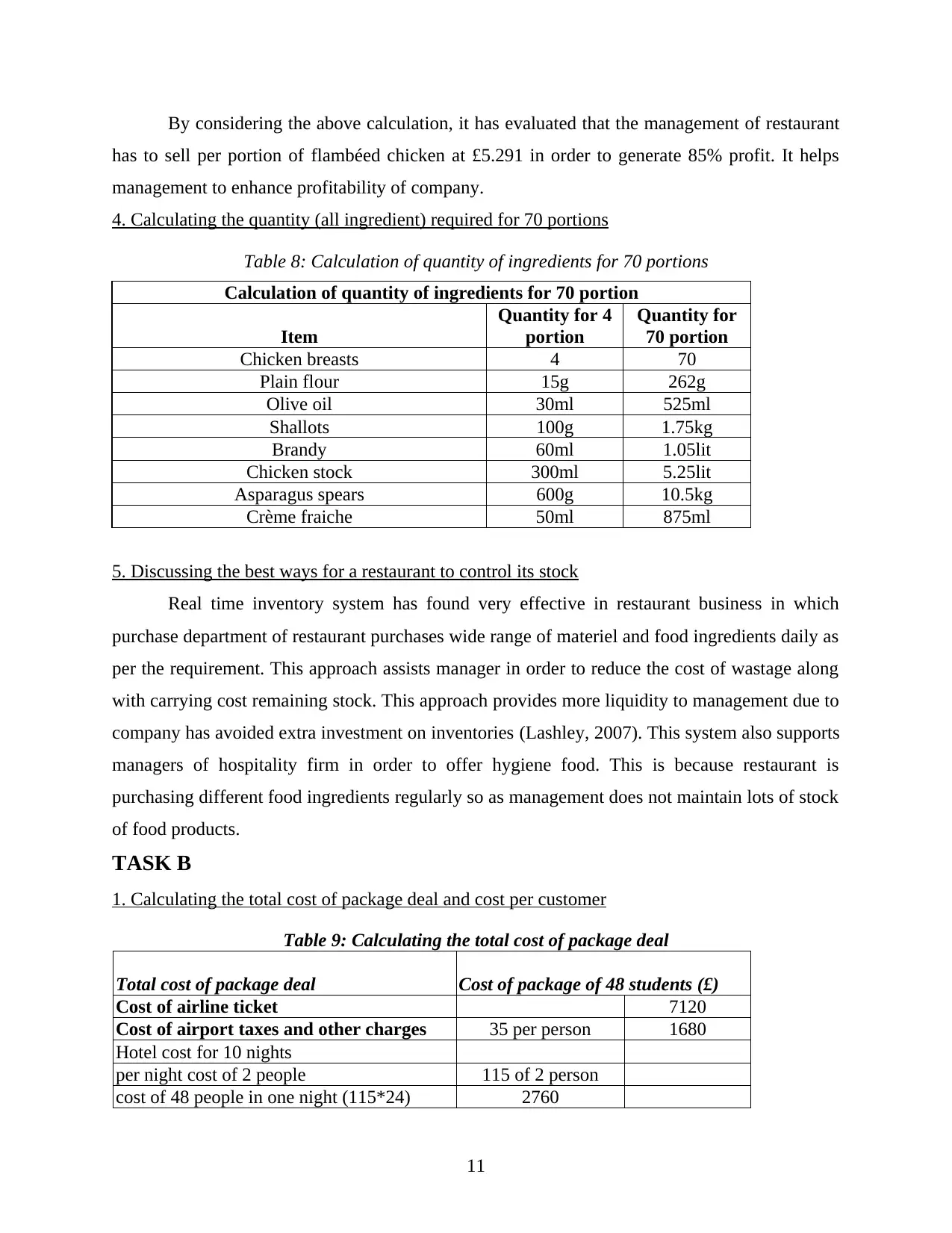
By considering the above calculation, it has evaluated that the management of restaurant
has to sell per portion of flambéed chicken at £5.291 in order to generate 85% profit. It helps
management to enhance profitability of company.
4. Calculating the quantity (all ingredient) required for 70 portions
Table 8: Calculation of quantity of ingredients for 70 portions
Calculation of quantity of ingredients for 70 portion
Item
Quantity for 4
portion
Quantity for
70 portion
Chicken breasts 4 70
Plain flour 15g 262g
Olive oil 30ml 525ml
Shallots 100g 1.75kg
Brandy 60ml 1.05lit
Chicken stock 300ml 5.25lit
Asparagus spears 600g 10.5kg
Crème fraiche 50ml 875ml
5. Discussing the best ways for a restaurant to control its stock
Real time inventory system has found very effective in restaurant business in which
purchase department of restaurant purchases wide range of materiel and food ingredients daily as
per the requirement. This approach assists manager in order to reduce the cost of wastage along
with carrying cost remaining stock. This approach provides more liquidity to management due to
company has avoided extra investment on inventories (Lashley, 2007). This system also supports
managers of hospitality firm in order to offer hygiene food. This is because restaurant is
purchasing different food ingredients regularly so as management does not maintain lots of stock
of food products.
TASK B
1. Calculating the total cost of package deal and cost per customer
Table 9: Calculating the total cost of package deal
Total cost of package deal Cost of package of 48 students (£)
Cost of airline ticket 7120
Cost of airport taxes and other charges 35 per person 1680
Hotel cost for 10 nights
per night cost of 2 people 115 of 2 person
cost of 48 people in one night (115*24) 2760
11
has to sell per portion of flambéed chicken at £5.291 in order to generate 85% profit. It helps
management to enhance profitability of company.
4. Calculating the quantity (all ingredient) required for 70 portions
Table 8: Calculation of quantity of ingredients for 70 portions
Calculation of quantity of ingredients for 70 portion
Item
Quantity for 4
portion
Quantity for
70 portion
Chicken breasts 4 70
Plain flour 15g 262g
Olive oil 30ml 525ml
Shallots 100g 1.75kg
Brandy 60ml 1.05lit
Chicken stock 300ml 5.25lit
Asparagus spears 600g 10.5kg
Crème fraiche 50ml 875ml
5. Discussing the best ways for a restaurant to control its stock
Real time inventory system has found very effective in restaurant business in which
purchase department of restaurant purchases wide range of materiel and food ingredients daily as
per the requirement. This approach assists manager in order to reduce the cost of wastage along
with carrying cost remaining stock. This approach provides more liquidity to management due to
company has avoided extra investment on inventories (Lashley, 2007). This system also supports
managers of hospitality firm in order to offer hygiene food. This is because restaurant is
purchasing different food ingredients regularly so as management does not maintain lots of stock
of food products.
TASK B
1. Calculating the total cost of package deal and cost per customer
Table 9: Calculating the total cost of package deal
Total cost of package deal Cost of package of 48 students (£)
Cost of airline ticket 7120
Cost of airport taxes and other charges 35 per person 1680
Hotel cost for 10 nights
per night cost of 2 people 115 of 2 person
cost of 48 people in one night (115*24) 2760
11
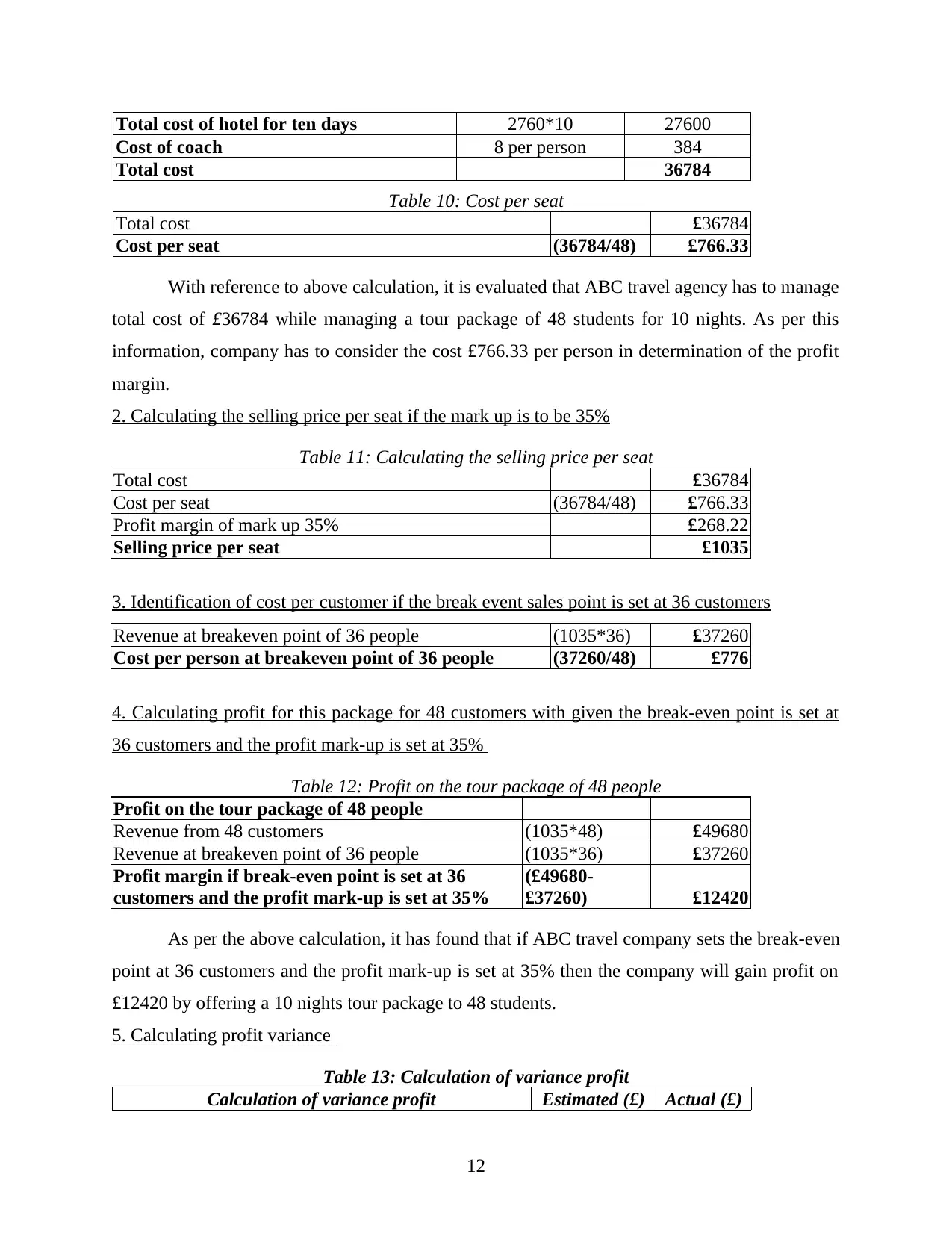
Total cost of hotel for ten days 2760*10 27600
Cost of coach 8 per person 384
Total cost 36784
Table 10: Cost per seat
Total cost £36784
Cost per seat (36784/48) £766.33
With reference to above calculation, it is evaluated that ABC travel agency has to manage
total cost of £36784 while managing a tour package of 48 students for 10 nights. As per this
information, company has to consider the cost £766.33 per person in determination of the profit
margin.
2. Calculating the selling price per seat if the mark up is to be 35%
Table 11: Calculating the selling price per seat
Total cost £36784
Cost per seat (36784/48) £766.33
Profit margin of mark up 35% £268.22
Selling price per seat £1035
3. Identification of cost per customer if the break event sales point is set at 36 customers
Revenue at breakeven point of 36 people (1035*36) £37260
Cost per person at breakeven point of 36 people (37260/48) £776
4. Calculating profit for this package for 48 customers with given the break-even point is set at
36 customers and the profit mark-up is set at 35%
Table 12: Profit on the tour package of 48 people
Profit on the tour package of 48 people
Revenue from 48 customers (1035*48) £49680
Revenue at breakeven point of 36 people (1035*36) £37260
Profit margin if break-even point is set at 36
customers and the profit mark-up is set at 35%
(£49680-
£37260) £12420
As per the above calculation, it has found that if ABC travel company sets the break-even
point at 36 customers and the profit mark-up is set at 35% then the company will gain profit on
£12420 by offering a 10 nights tour package to 48 students.
5. Calculating profit variance
Table 13: Calculation of variance profit
Calculation of variance profit Estimated (£) Actual (£)
12
Cost of coach 8 per person 384
Total cost 36784
Table 10: Cost per seat
Total cost £36784
Cost per seat (36784/48) £766.33
With reference to above calculation, it is evaluated that ABC travel agency has to manage
total cost of £36784 while managing a tour package of 48 students for 10 nights. As per this
information, company has to consider the cost £766.33 per person in determination of the profit
margin.
2. Calculating the selling price per seat if the mark up is to be 35%
Table 11: Calculating the selling price per seat
Total cost £36784
Cost per seat (36784/48) £766.33
Profit margin of mark up 35% £268.22
Selling price per seat £1035
3. Identification of cost per customer if the break event sales point is set at 36 customers
Revenue at breakeven point of 36 people (1035*36) £37260
Cost per person at breakeven point of 36 people (37260/48) £776
4. Calculating profit for this package for 48 customers with given the break-even point is set at
36 customers and the profit mark-up is set at 35%
Table 12: Profit on the tour package of 48 people
Profit on the tour package of 48 people
Revenue from 48 customers (1035*48) £49680
Revenue at breakeven point of 36 people (1035*36) £37260
Profit margin if break-even point is set at 36
customers and the profit mark-up is set at 35%
(£49680-
£37260) £12420
As per the above calculation, it has found that if ABC travel company sets the break-even
point at 36 customers and the profit mark-up is set at 35% then the company will gain profit on
£12420 by offering a 10 nights tour package to 48 students.
5. Calculating profit variance
Table 13: Calculation of variance profit
Calculation of variance profit Estimated (£) Actual (£)
12
⊘ This is a preview!⊘
Do you want full access?
Subscribe today to unlock all pages.

Trusted by 1+ million students worldwide
1 out of 14
Related Documents
Your All-in-One AI-Powered Toolkit for Academic Success.
+13062052269
info@desklib.com
Available 24*7 on WhatsApp / Email
![[object Object]](/_next/static/media/star-bottom.7253800d.svg)
Unlock your academic potential
Copyright © 2020–2025 A2Z Services. All Rights Reserved. Developed and managed by ZUCOL.





